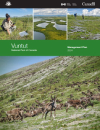Vuntut National Park of Canada Management Plan, 2024
Vuntut National Park
On this page
Foreword
From coast to coast to coast, national historic sites, national parks and national marine conservation areas are a source of shared pride for Canadians. They reflect Canada’s natural and cultural heritage and tell stories of who we are, including the historic and contemporary contributions of Indigenous peoples.
These cherished places are a priority for the Government of Canada. We are committed to protecting natural and cultural heritage, expanding the system of protected places, and contributing to the recovery of species at risk.
At the same time, we continue to offer new and innovative visitor and outreach programs and activities to ensure that more Canadians can experience these iconic destinations and learn about history, culture, and the environment.
In collaboration with Indigenous communities and key partners, Parks Canada conserves and protects national historic sites and national parks; enables people to discover and connect with history and nature; and helps sustain the economic value of these places for local and regional communities.
This new management plan for Vuntut National Park of Canada supports this vision.
Management plans are developed by a dedicated team at Parks Canada through extensive consultation and input from Indigenous partners, other partners and stakeholders, local communities, as well as visitors past and present. I would like to thank everyone who contributed to this plan for their commitment and spirit of cooperation.
As the Minister responsible for Parks Canada, I applaud this collaborative effort and I am pleased to approve the Vuntut National Park of Canada Management Plan.
Recommendations
Recommended by:
Pauline Frost
Chief
Vuntut Gwitchin First Nation
Ron Hallman
President & Chief Executive Officer
Parks Canada
Steve Climie
Chair
North Yukon Renewable Resources Council
Andrew Campbell
Senior Vice-President, Operations Directorate
Parks Canada
John Haselmayer
Superintendent, Yukon Field Unit
Parks Canada
Executive summary
Nan Thok Natr’iniin’aii, the Gwich’in name for Vuntut National Park, is a central part of Vuntut Gwitchin First Nation’s homeland. Vuntut National Park was established in 1995 as part of the Vuntut Gwitchin First Nation Final Agreement, to conserve, protect and present to Canadians a portion of the Northern Yukon Natural Region, to recognize Vuntut Gwitchin history and culture, and to protect the traditional and current use of the park by the Vuntut Gwitchin.
Parks Canada and Vuntut Gwitchin First Nation, cooperatively manage Vuntut National Park, with a key role played by the North Yukon Renewable Resources Council. This work is guided by the Vuntut Gwitchin First Nation Final Agreement and an operational agreement that defines the roles, responsibilities and procedures for the planning and management of the park. This includes recognizing traditional and current use of the park and established rights to subsistence harvesting, and providing for the protection of fish, wildlife, and their habitats. The Final Agreement takes precedence over any direction outlined in this management plan.
The 4,345-square-kilometre park sits within the Traditional Territory of the Vuntut Gwitchin, also known as “people of the lakes,” in the northwest corner of Yukon. The park is part of the Old Crow Flats Special Management Area and shares borders with Ivvavik National Park to the north and the Arctic National Wildlife Refuge in Alaska to the west.
The Vuntut Gwitchin are centered in Old Crow, a community of approximately 280 people, located 60 kilometres south of the park. It is a fly-in community with no permanent roads leading to it. Van Tat and the surrounding area, including Nan Thok Natr’iniin’aii, have long been an important resource that the Vuntut Gwitchin rely upon for their well-being including their economic and cultural activities. For millennia, they have used the area seasonally and in times of need. The Vuntut Gwitchin continue to be guided by their values to preserve, protect and maintain the Vuntut Gwitchin way of life, and use of the waters, lands and wildlife within their Traditional Territory through traditional and modern means.
This management plan sets a vision for the future of Vuntut National Park, with strategies and objectives aimed at reaching that vision. As such, this plan is the main guide for the management of the park, and an important accountability document for Indigenous peoples and Canadians as to how the park will be managed. Four key strategies are identified in the plan to guide the work of managing the park over the next ten years.
- Key strategy 1 focuses on building and maintaining healthy ecosystems in the park, for present and future generations
- Key strategy 2 focuses on supporting a strong, enduring traditional Vuntut Gwitchin lifestyle, with Elders passing teachings and language to youth, both in the community and out on the land
- Key strategy 3 focuses on honouring the enduring human presence in the park, by further understanding and managing the park’s cultural resources
- Key strategy 4 focuses on providing opportunities to learn about and experience Nan Thok Natr’iniin’aii, Vuntut Gwitchin history and Vuntut Gwitchin culture
This management plan will be reviewed in ten years’ time with the Vuntut Gwitchin First Nation and North Yukon Renewable Resources Council, as well as with Vuntut Gwitchin and other Canadians.
1.0 Introduction
Parks Canada administers one of the finest and most extensive systems of protected natural and historic places in the world. Parks Canada’s mandate is to protect and present these places for the benefit and enjoyment of current and future generations. Future-oriented, strategic management of each national historic site, national park, national marine conservation area and heritage canal administered by Parks Canada supports its vision:
Canada’s treasured natural and historic places will be a living legacy, connecting hearts and minds to a stronger, deeper understanding of the very essence of Canada.
The Canada National Parks Act and the Parks Canada Agency Act require Parks Canada to prepare a management plan for each national park. The Vuntut National Park of Canada Management Plan, once approved by the Minister responsible for Parks Canada and tabled in Parliament, ensures Parks Canada’s accountability to Canadians, outlining how park management will achieve measurable results in support of its mandate.
This national park is cooperatively managed with the Vuntut Gwitchin First Nation, with a key role played by the North Yukon Renewable Resources Council. The Vuntut Gwitchin First Nation and the North Yukon Renwable Resources Council were involved in the preparation of the management plan to meet the Vuntut Gwitchin First Nation Final Agreement provisions and shape the future direction of the heritage place.
Partners, stakeholders and the Canadian public have also been involved in the preparation of the management plan. The plan sets clear, strategic direction for the management and operation of Vuntut National Park by articulating a vision, key strategies and objectives. Parks Canada will report annually on progress toward achieving the plan objectives and will review the plan every ten years or sooner if required.
This plan is not an end in and of itself. Cooperative management partners will work together on the implementation of the management plan, to ensure that it remains relevant and meaningful. The plan will serve as the focus for ongoing engagement and, where appropriate, consultation, on the management of Vuntut National Park in years to come.
2.0 Significance of Vuntut National Park
Nan Thok Natr’iniin’aii, the Gwich’in name for Vuntut National Park, is a central part of Vuntut Gwitchin First Nation’s homeland. The 4,345-square-kilometre park sits within the Traditional Territory of the Vuntut Gwitchin, also known as “people of the lakes,” in the northwest corner of Yukon (Map 1). The park is part of the Old Crow Flats Special Management Area and shares borders with Ivvavik National Park to the north and the Arctic National Wildlife Refuge in Alaska to the west. For the purposes of this document “Nan Thok Natr’iniin’aii” will be used interchangeably with “the park” when referring to Vuntut National Park.
Vuntut National Park was established in 1995 as part of the Vuntut Gwitchin First Nation Final Agreement, to conserve, protect and present to Canadians a portion of the Northern Yukon Natural Region, to recognize Vuntut Gwitchin history and culture and to protect the traditional and current use of the park by the Vuntut Gwitchin. Nan Thok Natr’iniin’aii is located within a major cultural and subsistence area of the Vuntut Gwitchin. Vuntut Gwitchin presence in the park is important not only for the continuance of their culture, but also for understanding changes that are occurring on the land and providing guidance for park management.
Map 1: Regional setting
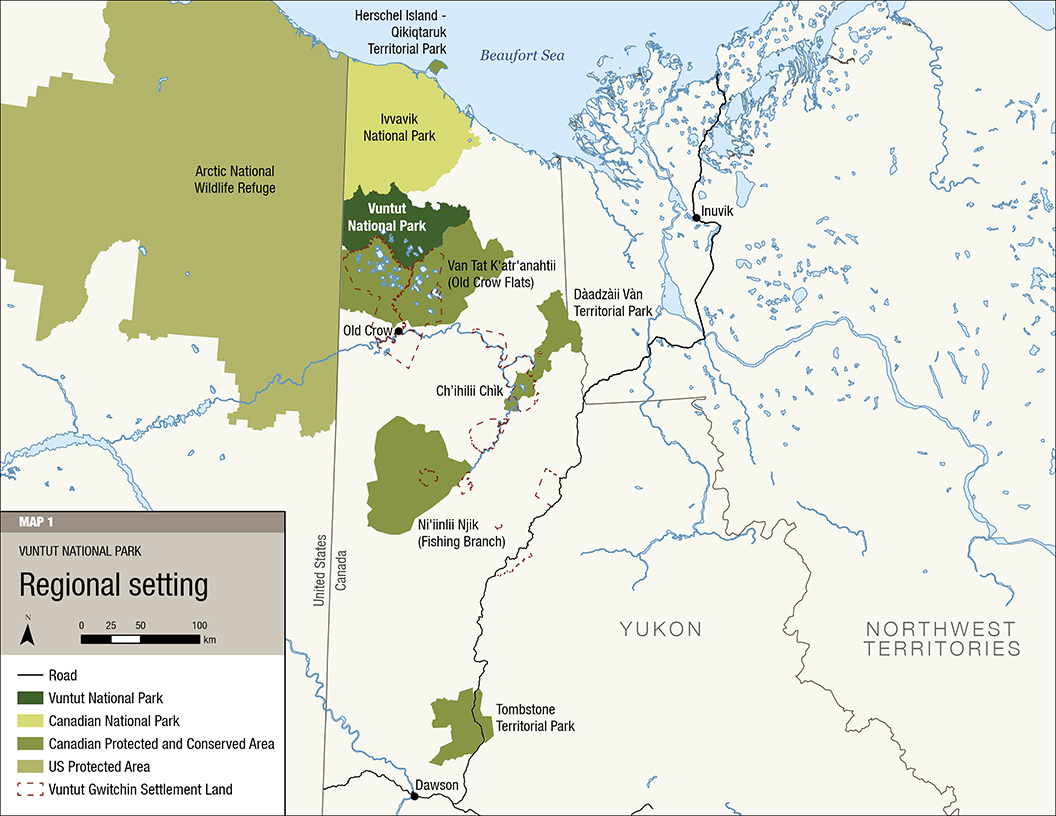
Map 1: Regional setting - Text version
This map shows the regional setting for Vuntut National Park in Northern Yukon between Alaska and the Northwest Territories. The park is part of the Old Crow Flats Special Management Area and shares borders with Ivvavik National Park to the north and the Arctic National Wildlife Refuge in Alaska to the west. The map contains a legend to the bottom left of the map with a 0 to 100 km scale.
Nan Thok Natr’iniin’aii is made up of two contrasting regions: wetlands and lakes in the south that give way to rolling hills, and scattered peaks in the north (Map 2).
The southern third of the park is comprised of the wetlands and lakes of Van Tat/Old Crow Flats, which is one of the most significant wetlands in Yukon, used by up to half a million waterfowl every year. Van Tat is listed as a Wetland of International Importance under the United Nations Ramsar Convention, an international designation on wetland conservation. The majority of Van Tat is outside of the park and is managed by Vuntut Gwitchin First Nation and the Government of Yukon.
The northern two-thirds of the park consist of the concave slopes and rolling hills of the Old Crow Basin and the foothills and scattered peaks of the British Mountains. Tundra dominates the landscape in this region of the park.
The park protects an important portion of the spring, summer and fall migration range of the Porcupine Caribou Herd and provides a crucial connection to the calving grounds within Ivvavik National Park to the north.
Several listed species at risk occur in the park, such as the grizzly bear, wolverine, and short-eared owl. The barren-ground caribou was recently recommended for listing under the Species at Risk Act and this recommendation is undergoing consideration. The barren-ground caribou, including the Porcupine Caribou Herd, is an ecologically and culturally important species in the region.
Map 2: Vuntut National Park
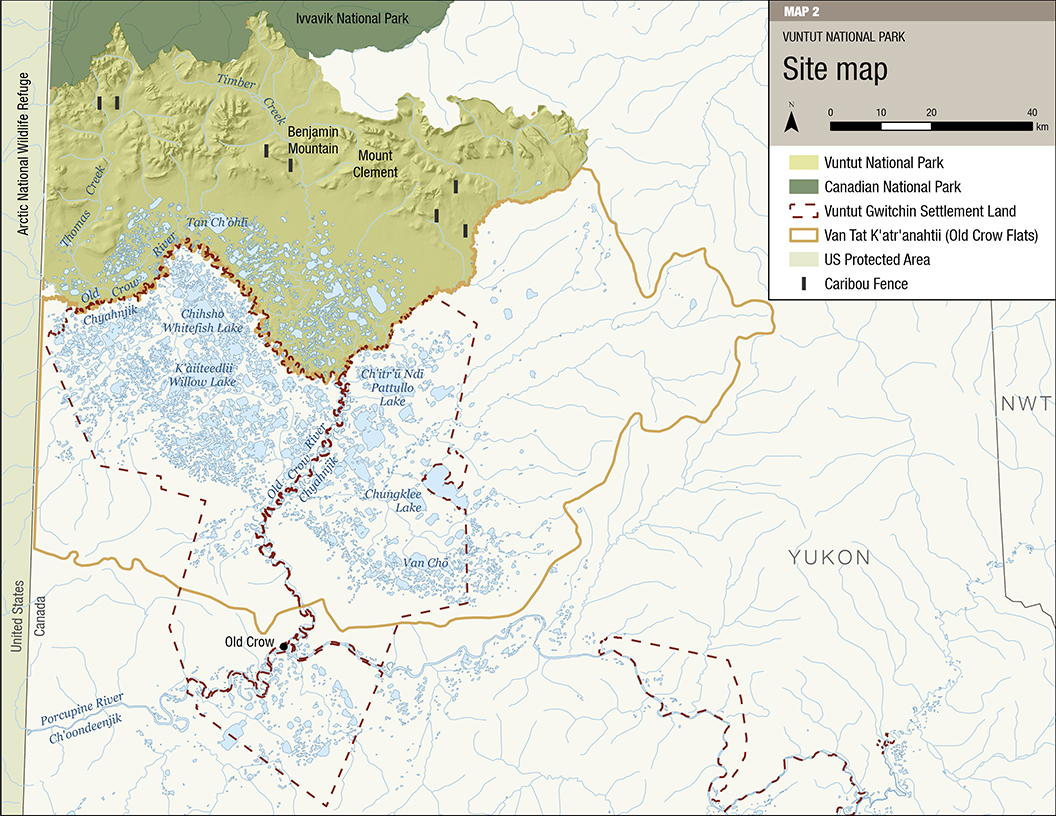
Map 2: Vuntut National Park - Text Version
This is a map of Vuntut National Park, showing Old Crow Flats, Vuntut Gwitchin Settlement Land in and adjacent to the park, and locations of the seven caribou fences across the central part of the park. The map contains a legend to the top right of the map with a 0 to 40 km scale.
The land that is now Nan Thok Natr’iniin’aii was once part of Beringia, a huge landmass in Yukon, Alaska, and northeastern Russia that remained generally ice-free during the last ice age. Many plants and animals of the area are thought to have survived the last ice age; some are found nowhere else in Canada. The area also features one of the world’s most abundant deposits of ice-age fossils. Noteworthy features of the park include: the northern third of Van Tat; spring, summer and fall migration range for the Porcupine Caribou Herd; the ongoing interdependence of the Vuntut Gwitchin and the land; caribou fences and other archaeological sites; and internationally significant palaeontological sites along the Old Crow River.
3.0 Planning context
In this section
- Context
- Caribou fences
- Traditional Knowledge
- Climate change
- Porcupine Caribou Herd
- Visitation
- Cultural resource management
Context
The Vuntut Gwitchin are centered in Old Crow, a community of approximately 280 people, located 60 kilometres south of the park (see Map 2). It is a fly-in community with no permanent roads leading to it. Van Tat and the surrounding area, including Nan Thok Natr’iniin’aii, have long been an important resource that the Vuntut Gwitchin rely upon for their well-being including economic and cultural activities. For millennia, they have used the area seasonally and in times of need. The Vuntut Gwitchin continue to be guided by their values to preserve, protect and maintain the Vuntut Gwitchin way of life, and use of the waters, lands and wildlife within their Traditional Territory through traditional and modern means.
Parks Canada and Vuntut Gwitchin First Nation cooperatively manage Vuntut National Park, with a key role played by the North Yukon Renewable Resources Council. This work is guided by the Vuntut Gwitchin First Nation Final Agreement and an operational agreement that defines the roles, responsibilities and procedures for the planning and management of Nan Thok Natr’iniin’aii. This includes recognizing traditional and current use of the park and established rights to subsistence harvesting, and providing for the protection of fish, wildlife, and their habitats. The Final Agreement takes precedence over any direction outlined in this management plan. Effective cooperative management continues to enhance deeper understanding and care of the park and neighbouring lands. The relationship amongst Parks Canada, Vuntut Gwitchin First Nation and North Yukon Renewable Resources Council is strong and built on a foundation of collaboration, trust and respect.
The cooperative management partners work closely with regional organizations for data and resource sharing, collaborative research, and advocacy. These groups include Government of Yukon, the Canadian Wildlife Service, the Alaska Department of Fish and Game, the U.S. Fish and Wildlife Service, the Porcupine Caribou Management Board, the Wildlife Management Advisory Council (North Slope), and numerous academic institutions.
Visitation to Vuntut National Park is extremely low with an average of one visitor per year. There are no visitor facilities in Vuntut National Park and access to the park is challenging. Visitors must be self-sufficient with excellent wilderness travel skills. There are established land and water access routes to the park that are utilized annually by Old Crow community members, including the Ch’anchał Trai/Crow Flats main trail in winter and the Old Crow River in early summer or fall depending on the water levels. Aircraft charters are available from Dawson or Inuvik.
The base of operations for the park is located in Old Crow. The John Tizya Centre was built through a partnership between Vuntut Gwitchin First Nation, the Vuntut Gwitchin Limited Partnership (previously known as the Vuntut Development Corporation), Parks Canada and Government of Yukon. It houses interpretive exhibits and offices for Parks Canada, Vuntut Gwitchin Government Heritage Department, North Yukon Renewable Resources Council and Government of Yukon. The Arctic Research Facility is a shared facility that provides storage for the park’s equipment. Pre-paid lease agreements have contributed to economic benefits for the Vuntut Gwitchin First Nation and the development of these mutually beneficial facilities.
The park contains a broad range of cultural resources, including navigation systems, Gwich’in place names, camp sites and village sites, which reflect human occupation and activity. There are 127 formally recorded archaeological sites in the park, most of which were recorded prior to park establishment. Seven caribou fences have been identified in the park – these were used by specific family groups from Old Crow and are of great significance in Vuntut Gwitchin history and culture. A wealth of palaeontological resources is found in the park: the Old Crow Basin has the greatest concentration of Pleistocene vertebrate fauna in Canada and possibly North America. Riverbank erosion has revealed Pleistocene fossils of mammoths, horses, muskoxen and other mammals. Both cultural and palaeontological resources are impacted by natural degradation and weathering.
Caribou fences
Until about 1920, the Gwich’in used caribou fences to harvest caribou. These wooden structures consisted of drift fences that spanned kilometres and guided caribou to a solidly built corral, which funneled caribou into a constricted area where they could be easily killed.
Evidence of this efficient harvesting method has been found across the north. Seven fences are located within Vuntut National Park, representing important archaeological and cultural sites.
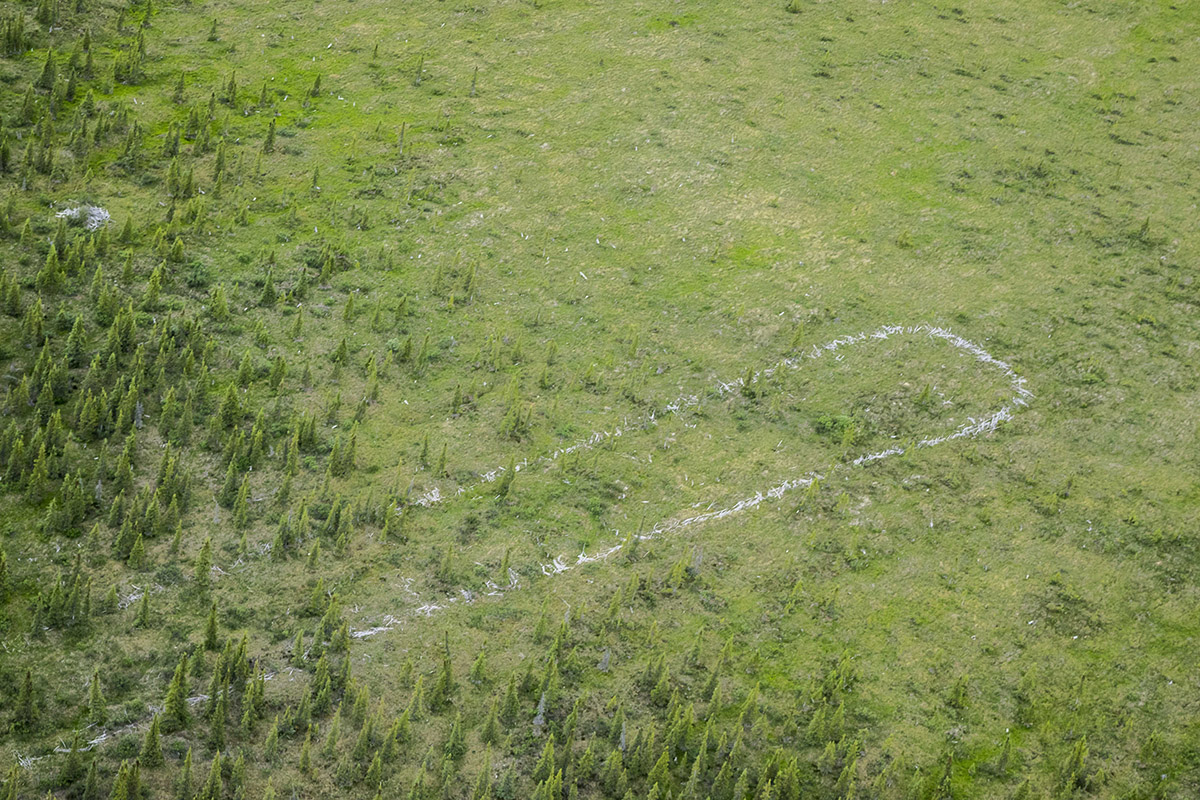
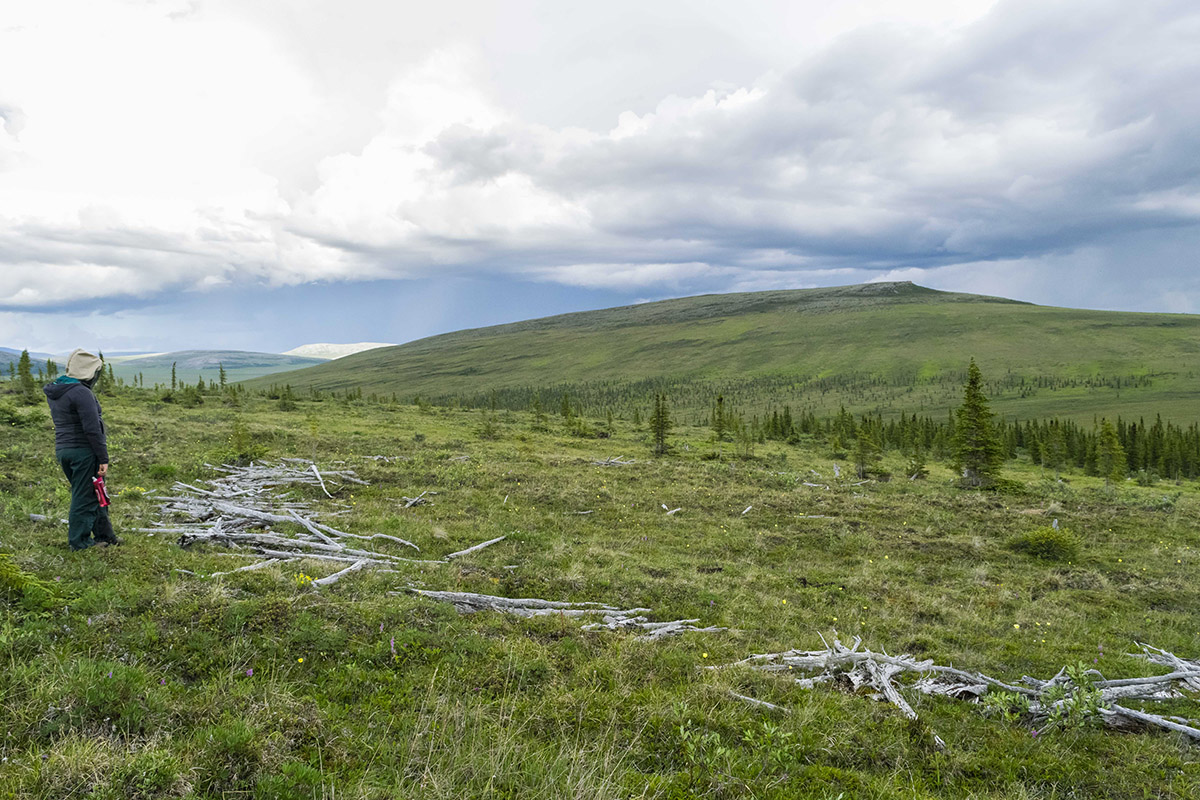
Vuntut Gwitchin Government’s Heritage Branch has been conducting intensive culture-related research projects on the land since 1995 with Elders, youth and other community members travelling by helicopter and boats throughout the Traditional Territory including the park. This has resulted in the recording, compilation and passing on of Traditional Knowledge. Vuntut Gwitchin Government has also developed a set of Van Tat Gwich’in Culture Indicators which reflect the human and cultural connection to Vuntut National Park, focusing on Van Tat Gwich’in oral history, cultural geography, cultural technology, navigation systems and language. Parks Canada actively supported these initiatives in the past and will continue to do so into the future.
Key priorities identified from the 2018 Vuntut National Park State of the Park Assessment, and through discussions with cooperative management partners, were considered during the development of this plan. These include:
Traditional Knowledge
Members of Vuntut Gwitchin Government, North Yukon Renewable Resources Council and the community are involved with many aspects of park management, helping to ensure that Traditional Knowledge is actively incorporated into decision-making. It is important that these efforts continue and that use of Traditional Knowledge in park management increases. Cooperative management partners can identify Traditional Knowledge holders and advise on how this knowledge can better inform management decisions. All partners have a desire to work together to support Elders in passing on their knowledge to youth, so the next generation is ready to care for the land. Another area for continued support is bringing Traditional Knowledge and science together in hands-on learning opportunities within the park and region.
Climate change
Increasing temperatures and thawing permafrost are impacting the lands and wetlands in the Van Tat area as well as tundra vegetation in the park. These impacts are only just starting to be understood. Climate change is expected to continue to have significant impacts on the ecology of the park over the next management planning period. The impacts of climate change are a major concern and are difficult to address at the local level. Over the next ten years, it will be important to have a better understanding of regional climate change effects in order to inform adaptation strategies for Nan Thok Natr’iniin’aii.
Porcupine Caribou Herd
The Porcupine Caribou Herd’s range extends from Northern Alaska, across Yukon, to the Northwest Territories. The herd is critically important to the Vuntut Gwitchin as a valued resource and primary source of sustenance. Protecting the herd’s habitat was one of the main reasons Nan Thok Natr’iniin’aii was created. The latest count of the herd, conducted in 2017, showed that the herd was at a historical high of approximately 218,000 caribou. Oil and gas development in the Arctic National Wildlife Refuge, home to the herd’s core calving grounds, continues to be a threat, with development likely to occur over the next ten years. Focused efforts with cooperative management partners and other organizations, such as the Porcupine Caribou Management Board, will be required to influence protection measures of the herd’s core calving grounds in the Alaska National Wildlife Refuge.
Visitation
Remote Nan Thok Natr’iniin’aii is one of the least visited national parks in Canada due to complicated logistics, high travel costs and lack of recreational options for visitors. Visitation without Vuntut Gwitchin guides is extremely difficult and cultivating local tourism is a priority. Suitable fixed wing landing sites are lacking. The John Tizya Centre offers visitors an opportunity to experience the park and learn about Vuntut Gwitchin culture as well as other protected areas in Vuntut Gwitchin Traditional Territory.
Cultural resource management
Up-to-date information on the park’s cultural resources is limited, affecting the ability to develop strategic direction for their management. Thirteen of the park’s 127 archaeological sites have been formally evaluated and five of the seven caribou fences have been recorded in detail. The 2014 Cultural Resource Values Statement for Vuntut National Park provides valuable context. However, additional information is needed to help set priorities for the management of specific cultural resources. Cultural resource management is difficult because of the remoteness of the park, complicated logistics and high travel costs to bring up specialists from southern Canada. This all leads to very limited condition monitoring of the known cultural resources within the park.
4.0 Development of the management plan
This management plan was co-developed with the Vuntut Gwitchin First Nation and North Yukon Renewable Resources Council. As with all national park planning programs, completing a “state of the park” assessment was one of the first steps. Consideration of many other topics and opportunities shaped the management plan, including the Vuntut Gwitchin First Nation Final Agreement, cooperative management board strategic priorities, and comments from two phases of consultation.
The first phase of consultation was held with community members at an open house in Old Crow in February 2019 as the draft plan was being developed. The purpose of this consultation was threefold: introduce the planning program; identify opportunities to be involved in shaping the management plan; and obtain feedback on initial strategic direction for the draft plan based on meetings between the cooperative management board.
In March 2020, in consideration of the global COVID-19 pandemic, consultations related to management planning were temporarily suspended. Consultation on management planning for Vuntut resumed in August of 2023 when a second phase of consultation was held for a six-week period to a wider audience including the park’s stakeholders, public organizations and the public. The purpose of this consultation was to obtain feedback on the park’s draft management plan.
All feedback provided in both phases of consultation was carefully reviewed and considered to finalize this management plan. Many thanks to all who participated. Your feedback helped to shape the management plan for the park.
5.0 Vision
This vision expresses the desired future of Vuntut National Park in 15 to 20 years, serving as a foundation for this management plan.
Nan Thok Natr’iniin’aii is a dynamic and diverse protected area set within a larger sustainable landscape context. It is a place where the Vuntut Gwitchin continue to exist in harmony with the water, land and animals as they have for thousands of years, and where a strong, progressive Vuntut Gwitchin culture is shared with those who come to visit and explore.
The traditional village of Old Crow is the link to the national park, where a warm welcome awaits you at the John Tizya Centre, and Vuntut Gwitchin guides are ready to support your journey. Take off your heavy boots, throw on some mukluks and snowshoe under a veil of northern lights. Or jump into a canoe and paddle toward the horizon under the endless midsummer sun. Far from the chaos of city life, immerse yourself in the sights, sounds and smells of this natural haven with healthy ecosystems of pristine waters, land and animals. Listen to the buzz of the bumblebee bringing life and sustenance within the park; observe the powerful grizzly foraging for food to sustain them through a long winter sleep; hear the swoosh of the geese or the calls of thousands of waterfowl in Van Tat; experience refuge from the last ice age with a chance of discovering mammoth teeth or other fossils in these Beringian lands.
The Porcupine Caribou Herd thrive as they traverse their ancient routes to and from the calving grounds. With one of the longest terrestrial migrations in the world, Porcupine Caribou are at the cultural heart of existence for Vuntut Gwitchin, providing for many of their material and subsistence needs, as reaffirmed by the amazing engineering feats of the caribou fences.
The Vuntut Gwitchin, North Yukon Renewable Resources Council, and Vuntut National Park staff understand the responsibility and honour that comes with being stewards of this land. Together, Traditional Knowledge holders and scientists strive to understand a changing landscape and share vital information for maintaining a balance to exist on and care for this land.
The lives of Vuntut Gwitchin citizens are enriched by visits to the park that foster connections to their roots and a sense of pride for their culture and traditions. Elders share their values and pass on their skills, empowering the youth of today to have a strong sense of belonging that is passed down to the grandchildren of tomorrow, continuing an adaptive and resilient way of life that has survived for thousands of years.
6.0 Key strategies
In this section
- Key strategy 1: Looking after the water, land and animals for the future
- Key strategy 2: Living and teaching a traditional lifestyle
- Key strategy 3: Our past shapes our future
- Key strategy 4: Experiencing and appreciating Vuntut Gwitchin country
Four key strategies frame how the park will be managed over the next ten years. The strategies, and their corresponding objectives and targets, focus on achieving the park’s vision through cooperative management. Unless otherwise specified, all targets are meant to be achieved within the ten-year period of the plan. Yearly implementation updates will be provided to engage the Vuntut Gwitchin, key stakeholders and Canadians.
Key strategy 1
Looking after the water, land and animals for the future
The focus of this strategy is building and maintaining healthy ecosystems in the park, for present and future generations, by fostering a culture of stewardship. An ecologically strong park contributes to the health of the region as a whole and is resilient in the face of a changing climate. Parks Canada will continue to implement the park’s ecological integrity monitoring program, while working collaboratively with Vuntut Gwitchin First Nation and North Yukon Renewable Resources Council to incorporate Traditional Knowledge and science into decision-making. The strategy also emphasizes the need to protect the Porcupine Caribou Herd. Porcupine Caribou migrate far beyond park boundaries, and it is a high priority to work collaboratively to conserve the population. Participation in the Porcupine Caribou Management Board and Porcupine Caribou Technical Committee is ongoing, along with collaboration with all other partners and stakeholders involved in Porcupine Caribou management. Together with other relevant agencies, Parks Canada will also continue to advocate the importance of protecting the Porcupine Caribou Herd’s calving grounds in the Alaska National Wildlife Refuge.
Effects of climate change, such as permafrost melting, altered fire regimes, draining lakes and changes to caribou habitat, are wide reaching and will impact human and ecosystem health as well as park resources. Over the next ten years, cooperative management partners need to better understand these impacts through documentation, knowledge transfer, new research partnerships, and vulnerability and risk assessments. Impacts of climate change will be considered and integrated in all aspects of park planning and management.
Objective 1.1
The ecological integrity of the park is maintained or improved.
Targets
- All ecological integrity measures for the tundra ecosystem (close to the mountains) are rated in the next state of the park assessment
- The trend of the park ecological integrity measures is stable in the next state of the park assessment
Objective 1.2
Collaborative management and planning leads to improved decision making with Vuntut Gwitchin First Nation, North Yukon Renewable Resources Council and Porcupine Caribou Management Board to achieve mutually supported ecological integrity objectives.
Targets
- Cooperative management partners are satisfied that decision making within the protected area network is integrated
- All ecological integrity objectives for Vuntut National Park align with mutually supported ecological integrity objectives within the protected area network
Objective 1.3
The health and size of the Porcupine Caribou Herd is maintained, and sensitive habitats are protected.
Targets
- Parks Canada continues to work collaboratively with the Porcupine Caribou Management Board in implementing the Harvest Management Plan
- The level of understanding of Porcupine Caribou summer habitat and use, and how they are changing, has increased from 2023 levels
Key strategy 2
Living and teaching a traditional lifestyle
The focus of this strategy is to support a strong, enduring traditional Vuntut Gwitchin lifestyle, with Elders passing teachings and language to youth, both in the community and out on the land. Nan Thok Natr’iniin’aii is part of the Vuntut Gwitchin’s homeland. The Vuntut Gwitchin have a long-term perspective on the health of the park based on generations of observations and on an understanding of species and habitats. Vuntut Gwitchin presence in the park is important not only for the continuance of their culture, but also for understanding changes that are occurring on the land and providing guidance for managing natural and cultural resources. Working with Vuntut Gwitchin First Nation, Parks Canada will continue to take every reasonable opportunity to support Vuntut Gwitchin, in particular youth and Elders, to spend time on the land, and to facilitate the sharing of knowledge.
Objective 2.1
Vuntut Gwitchin connections to the park are strengthened.
Targets
- The number of opportunities for community members to share their knowledge in the park, facilitated by Parks Canada and Vuntut Gwitchin First Nation, has increased from 2023 levels
- With Parks Canada and Vuntut Gwitchin First Nation support, the number of cultural learning experiences in the Old Crow region, such as culture or harvest camps, continues to be maintained
Objective 2.2
Youth have a strong sense of belonging and are empowered to care for the park.
Target
- The number of youth engaged with the park has increased from 2023 levels; for example, through youth camps, educational programs, or a Guardian Program
Objective 2.3
The cooperative management partners collaborate to meet obligations set out in the Final Agreement, contributing to the economic well-being of the community.
Target
- Obligations set out in the Vuntut Gwitchin First Nation Final Agreement related to economic benefits, such as employment, procurement and contracting opportunities, continue to be met over the next ten years
Key strategy 3
Our past shapes our future
The focus of this strategy is to honour the enduring human presence in Nan Thok Natr’iniin’aii, by further understanding and managing the park’s cultural resources. The cultural sites of Vuntut National Park attest to Vuntut Gwitchin history and the peoples’ enduring relationship with the land. These sites span thousands of years, from paleolithic archaeological finds, which may be as much as 35,000 years old, to historic fishing and trapping camps used by many generations of the Vuntut Gwitchin.
Parks Canada will continue to develop, with the cooperative management partners, the Van Tat Gwich’in Culture Indicators as part of the state of the park assessment process. These indicators reflect the human and cultural connection to Vuntut National Park, focusing on Van Tat Gwich’in oral history, cultural geography, cultural technology, navigation systems and language.
The palaeontological resources found in the park are largely protected from human impact due to their inaccessibility. Parks Canada will continue to work with partners to share knowledge and understanding of these resources in the region.
Objective 3.1
Understanding and management of cultural and palaeontological resources found in the park are improved.
Targets
- Guidelines for visiting caribou fences, and other culturally sensitive sites, are developed
- Based on the 2014 Cultural Resource Values Statement for Vuntut National Park, cultural resource and palaeontological management priorities are defined
Key strategy
Experiencing and appreciating Vuntut Gwitchin country
The focus of this key strategy is to provide opportunities to learn about and experience Nan Thok Natr’iniin’aii, Vuntut Gwitchin history and Vuntut Gwitchin culture. Increasing the awareness of Nan Thok Natr’iniin’aii well beyond its boundaries, in the hearts and minds of Canadians and people around the world, is an essential part of this strategy. People who connect to the park will feel welcomed and will have a greater understanding and appreciation of the unique natural and cultural landscapes of Nan Thok Natr’iniin’aii. It will be important to continue to ensure that Vuntut Gwitchin rights within the park are recognized, protected, understood and supported by park staff, visitors and Canadians. The Vuntut Gwitchin are supported in actively sharing their stories and traditions about the park and the region with Canadians.
Objective 4.1
Tourism capacity in and around the community of Old Crow is enhanced.
Target
- Tourism initiatives in and around the community of Old Crow are supported by Parks Canada, as guided by Vuntut Gwitchin First Nation
Objective 4.2
The possibility of developing new ways to experience the park is explored.
Target
- Cooperative management partners work together to determine the feasibility of visitor opportunities and support their exploration
Objective 4.3
Awareness and understanding of Gwich’in culture, the value of the park’s natural, cultural and palaeontological resources, and the park’s role as a protected area increases amongst local community members and Canadians.
Targets
- Key stories related to the park’s values and management shared with Canadians increase from 2023 levels
- Virtual reach has increased by 25% (through website, social media, videos and emerging technology) from 2023 levels
- Communications objectives around key values of the park, as outlined in the 2014 Cultural Resources Values Statement for Vuntut National Park continue to be met
7.0 Zoning and declared wilderness area
In this section
- Zoning
- Zone I — Special preservation
- Zone II — Wilderness
- Zone III — Natural environment
- Wilderness area declaration
7.1 Zoning
Zoning is an important management tool with ecological integrity as its primary consideration. Vuntut National Park’s cooperative management partners use Parks Canada’s zoning system to define where particular visitor use activities can occur, based on the ability of the land to support those activities, while ensuring that rare, sensitive ecological or cultural areas are protected. The zoning system does not impact subsistence use and resource harvesting rights of the Vuntut Gwitchin, using traditional and modern means.
Parks Canada’s national park zoning system is an integrated approach to the classification of land and water areas in a national park and designates where particular activities can occur on land or water based on the ability to support those uses.
The zoning system has five categories:
- Zone I – Special Preservation
- Zone II – Wilderness
- Zone III – Natural Environment
- Zone IV – Outdoor Recreation
- Zone V – Park Services
Three Parks Canada zones are applicable within Vuntut National Park (Map 3):
- Zone I – Special Preservation
- Zone II – Wilderness
- Zone III – Natural Environment (winter months only)
Zoning in this management plan has not changed since the 2010 management plan.
Zone I — Special preservation (less than 0.025%)
Zone I is the most protective category in the Parks Canada zoning system. Within Zone I areas, preservation is the primary concern and public use is controlled to protect especially important or fragile resources. This zone is applied to areas of the park that are among the best examples of the features that represent the natural region, or that support outstanding or rare natural or cultural features. In this zone no motorized access is permitted, including visitor air access. Natural features may be interpreted off site.
The seven caribou fence complexes within the park are identified as Zone I areas, totalling less than one square kilometre. Spot zoning ensures that the caribou fences and associated structures are protected, while enabling aircraft landings in nearby Zone II areas.
Zone II — Wilderness (approximately 99.97% [77.11% in winter months])
Zone II contains extensive areas that protect representative natural landscapes and are conserved in a wilderness state. The perpetuation of ecosystems with minimal human interference is the key consideration. Visitor experiences are focused on self-propelled activities. Motorized use is generally not permitted, although strictly controlled air access is authorized in remote northern parks like Vuntut National Park.
The vast majority of the park is classified as Zone II, encompassing 4,344 square kilometres.
Zone III — Natural environment (approximately 22.86% in winter months)
Zone III areas are managed as natural environments that are capable of supporting a range of visitor experiences. These areas enable visitors to enjoy and learn about the park’s natural and cultural features through outdoor recreational and educational activities requiring minimal facilities and services. Limited motorized access is permitted.
There is a temporal Zone III area in the southeast portion of the park (Map 3), used during the winter months when the lakes in Old Crow Flats are frozen and waterfowl are absent. The only motorized activities permitted are guided commercial snowmobile trips and snowmobile-supported commercial dog sled trips, led by Vuntut Gwitchin citizens, as per the Final Agreement. This zone encompasses 993 square kilometres.
Map 3: Vuntut National Park zoning
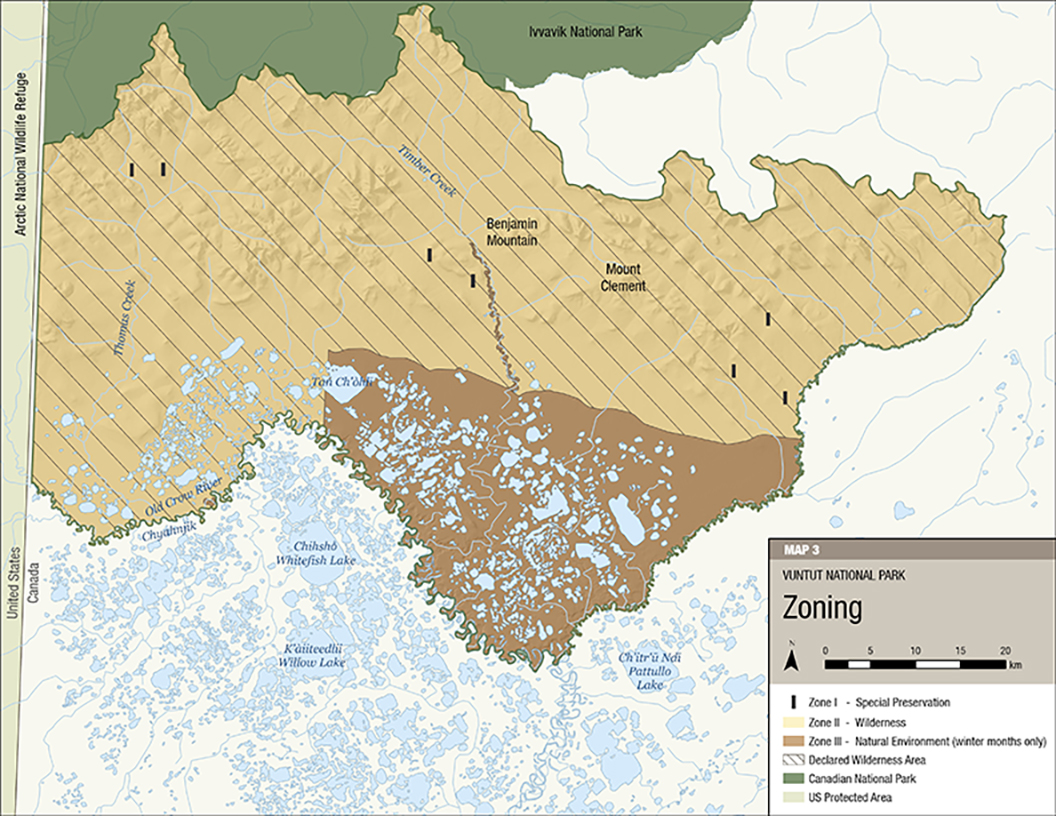
Map 3: Vuntut National Park zoning - Text Version
This map identifies the various zones where particular visitor use activities can occur in Vuntut National Park. The zoning system does not impact subsistence use and resource harvesting rights of the Vuntut Gwitchin, using traditional and modern means. The map contains a legend to the bottom right of the map with a 0 to 20 km scale. The cooperative management partners identified three zones for the park: Zone I Special Preservation to protect the seven caribou fences located in the western, central and eastern part of the park; Zone II Wilderness that makes up the vast majority of land within the park; and Zone III Natural Environment located in the southeast portion of the park, which is a temporary zone in the winter months where the only motorized activities permitted for visitors are guided commercial snowmobile trips and snowmobile-supported commercial dog sled trips, led by Vuntut Gwitchin citizens, as per the Final Agreement. The map also identifies the declared Wilderness Area of the park in the area north of Old Crow Flats.
7.2 Wilderness area declaration
The intent of legally designating a portion of a national park as wilderness is to maintain its wilderness character in perpetuity. Only activities that are unlikely to impair the wilderness character of the area may be authorized within the declared wilderness area of Vuntut National Park.
In 2009, the area north of Old Crow Flats was declared a Wilderness Area, encompassing 3,352 square kilometres (77% of the park) as illustrated on Map 3.
Wilderness areas are legally designated lands within national parks that are found in a natural state or are capable of returning to a natural state. The intent of wilderness declaration is to assist in ensuring a high level of ecological integrity by preventing activities likely to impair wilderness character and to maintain its wilderness character in perpetuity. The designation is the highest degree of assurance that development and uses inconsistent with wilderness character will not occur. Only those facilities and activities required for essential services and the protection of park resources will be permitted in declared wilderness areas.
8.0 Summary of strategic environmental assessment
All national park management plans are assessed through a strategic environmental assessment to understand the potential for cumulative effects. This understanding contributes to evidence-based decision-making that supports ecological integrity being maintained or restored over the life of the plan. The strategic environmental assessment for the management plan for Vuntut National Park considered the potential impacts of climate change, local and regional activities around the park, and proposals within the management plan. The strategic environmental assessment assessed the potential impacts on different aspects of the ecosystem, including caribou, tundra and wetland ecosystem health, and species at risk.
The park’s natural environment is in good condition. Porcupine Caribou Herd size, and other measures of Tundra and Wetland Ecosystem health are all ranked as good condition according to ongoing Ecological Integrity Monitoring and the most recent State of the Park Assessment. However, climate change and development outside of the park boundaries may cause impacts. The management plan includes strategies to understand these potential impacts, including:
- research conducted by Parks Canada, together with the Government of Yukon, academic institutions, and Vuntut Gwitchin, to understand the impacts of different stressors on the park
- working with these partners to use both Traditional Knowledge and western science to increase understanding of the natural and cultural resources of the park and the area around it
- working with Vuntut Gwitchin First Nation and North Yukon Renewable Resources Council to strengthen regional interests and improve relations and strengthen community members’ connections to the park
- working with these partners to meet operational requirements and management needs
The Vuntut Gwitchin, stakeholders and the public were provided with opportunities to provide comments on the draft plan, and a summary of the draft strategic environmental assessment. Comments from the public, Indigenous groups, and stakeholders were incorporated into the strategic environmental assessment and management plan as appropriate.
The strategic environmental assessment was conducted in accordance with the Cabinet Directive on the Environmental Assessment of Policy, Plan and Program Proposals (2010) and facilitated an evaluation of how the management plan contributed to the Federal Sustainable Development Strategy. Individual projects undertaken to implement management plan objectives at the site will be evaluated to determine if an impact assessment is required under the Yukon Environmental and Socio-economic Assessment Act (2003), or successor legislation. The management plan supports the Federal Sustainable Development Strategy goals of Greening Government, Sustainably Managed Lands and Forests, Healthy Wildlife Populations, Connecting Canadians with Nature, and Safe and Healthy Communities.
Many positive environmental effects are expected and there are no important negative environmental effects anticipated from implementation of the Vuntut National Park management plan.
Contact us
For more information about the management plan or about Vuntut National Park of Canada:
Vuntut National Park of Canada
Box 19
Old Crow, YT Y0B 1N0
Publication information
© His Majesty the King in Right of Canada, represented by the President & Chief Executive Officer of Parks Canada, 2024.
Front cover image credits
Top from left to right: Ian McDonald, Jeffery Peter, and Jeffery Peter
Bottom: Ian McDonald
Cette publication est aussi disponible en français :
Plan directeur du Parc national du Canada Vuntut, 2024
-
R64-105/95–2024 E
-
978-0-660-70154-7
-
R64-105/95-2024E-PDF
-
978-0-660-70153-0
- Date modified :
